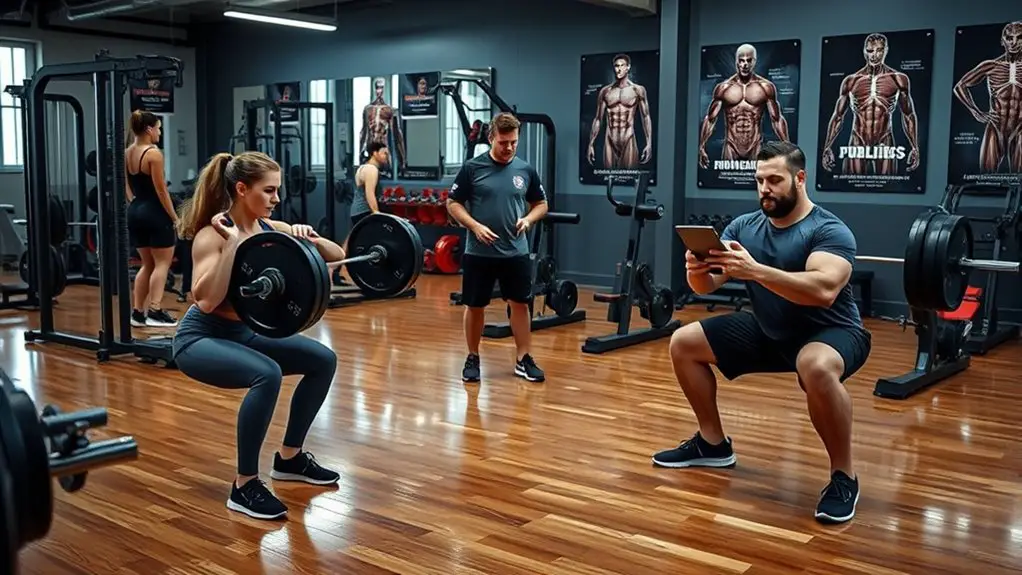The Best Gym Workouts Backed by Sports Science

The best gym workouts are rooted in sports science principles. High-Intensity Interval Training (HIIT) efficiently boosts fat loss and metabolism. Resistance training, focusing on compound movements, builds muscle strength and size. Incorporating plyometric exercises enhances power and speed. Structuring your workouts through periodization maximizes overall performance while ensuring adequate recovery is essential for muscle growth. Also, aligning your nutrition with your fitness goals can amplify results. There’s more to discover about optimizing your workout regimen effectively.
Understanding the Principles of Sports Science in Fitness

While you may already be familiar with various workout routines, understanding the principles of sports science can greatly enhance your fitness journey. Exercise physiology focuses on how your body responds to physical activity, helping you tailor workouts that optimize energy systems and recovery. By grasping these concepts, you can effectively manage training intensity and duration to prevent overtraining and injuries. Additionally, monitoring heart rate during workouts is essential for ensuring you reach the appropriate intensity levels for optimal performance.
Moreover, biomechanics principles play an important role in maximizing your performance. Analyzing movement patterns allows you to identify inefficiencies and adjust your technique, resulting in improved strength and endurance. For instance, understanding the role of joint angles and muscle recruitment can lead to more effective exercises that target specific muscle groups.
High-Intensity Interval Training (HIIT) for Maximum Fat Loss
High-Intensity Interval Training (HIIT) is a powerful tool for fat loss, leveraging short bursts of intense exercise followed by rest or low-intensity periods. Studies show it can boost your metabolism and improve cardiovascular health more effectively than traditional steady-state cardio. However, understanding effective HIIT workouts and safety tips is essential to maximize benefits while minimizing injury risk.
Benefits of HIIT
If you’re looking to maximize fat loss effectively, incorporating HIIT into your workout routine can be a game changer. HIIT benefits include not just improved calorie burning during workouts but also a significant post-exercise metabolic boost. Research shows that high-intensity intervals elevate your heart rate, leading to increased oxygen consumption and energy expenditure long after your session ends. This afterburn effect can help you burn more calories throughout the day, enhancing overall fat loss. Additionally, HIIT workouts typically require less time than traditional cardio, making them a practical option for busy schedules. By efficiently combining intensity and rest, you can improve cardiovascular fitness while promoting fat loss, making HIIT a highly effective training method for your fitness goals.
Effective HIIT Workouts
To achieve maximum fat loss through HIIT, it’s essential to design workouts that incorporate a variety of exercises and interval structures. Research shows that creative HIIT formats, such as circuit training or tabata, can enhance metabolic rate and promote fat oxidation. For best results, aim for a HIIT workout duration of 20 to 30 minutes, allowing for intense bursts of activity followed by short recovery periods. A typical structure could involve 30 seconds of high-intensity activity, like sprints or burpees, followed by 15 seconds of rest. This approach not only boosts cardiovascular fitness but also maximizes calorie burn. By varying your exercises and maintaining appropriate durations, you’ll keep your body challenged and engaged, leading to sustainable fat loss.
Safety Tips for HIIT
Engaging in HIIT can yield impressive results, but it’s vital to prioritize safety to prevent injury and guarantee long-term success. Start with effective warm-up strategies that prepare your muscles and joints for intense activity; dynamic stretches or light cardio are great options. Focus on proper HIIT techniques, ensuring you’re using correct form to minimize strain. Hydration is fundamental—drink water before, during, and after your workout to maintain performance and recovery. Don’t overlook cooldown importance; this helps your heart rate gradually return to normal and aids in muscle recovery. By implementing these strategies, you greatly reduce the risk of injury and enhance the overall effectiveness of your HIIT sessions. Prioritize safety, and your body will thank you in the long run.
The Benefits of Resistance Training for Muscle Building
Building muscle through resistance training offers a profound sense of empowerment and achievement. Engaging in structured resistance training activates muscle hypertrophy techniques, allowing you to effectively increase muscle size and strength. Research consistently shows that progressive overload—gradually increasing weights—stimulates muscle fibers, leading to ideal growth.
Many resistance training myths, such as the belief that lifting heavy only is the key to gains, can mislead your approach. In reality, a well-rounded program incorporating various rep ranges and exercises is essential for balanced development. Additionally, consistency in your training regimen, along with adequate nutrition and recovery, plays a critical role in achieving your muscle-building goals.
Plyometric Workouts to Enhance Power and Agility

Plyometric training greatly boosts your power and agility by utilizing explosive movements that engage fast-twitch muscle fibers. Research shows that incorporating effective plyometric exercises, such as box jumps and burpees, can enhance athletic performance and improve overall fitness. By focusing on these workouts, you can achieve greater strength and speed in your activities.
Benefits of Plyometric Training
While many workout routines focus solely on strength and endurance, incorporating plyometric training can greatly enhance your power and agility. Plyometric benefits include improved explosive strength, which is essential for athletes across various sports. Research shows that these high-intensity, explosive movements activate fast-twitch muscle fibers, leading to increased muscle power and faster reaction times. This training method not only boosts athletic performance but also enhances overall functional fitness, making everyday activities easier. In addition, plyometric exercises can improve cardiovascular endurance and coordination, contributing to a well-rounded fitness regimen. By integrating plyometrics into your workouts, you’re setting the foundation for greater athletic potential and reducing the risk of injury through better body control and stability.
Effective Plyometric Exercises
To effectively enhance your power and agility, it’s crucial to incorporate a variety of plyometric exercises into your training routine. Start with basic jump techniques such as squat jumps and box jumps, focusing on proper form and explosive movement. As you progress, consider plyometric progression, gradually increasing the intensity and complexity of your workouts. Incorporate depth jumps and lateral bounds to challenge your muscles and improve proprioception. Evidence suggests that these exercises not only boost power output but also enhance neuromuscular coordination. Remember to include adequate recovery between sets to maximize performance and reduce injury risk. Consistently integrating these plyometric workouts will lead to significant improvements in both agility and overall athletic performance.
Aerobic vs. Anaerobic Exercises: Finding the Right Balance
Understanding the distinctions between aerobic and anaerobic exercises is essential for optimizing your fitness routine. Aerobic exercises, like running or cycling, leverage oxygen for sustained energy, offering aerobic advantages such as improved cardiovascular health and increased endurance. These activities can be performed for longer durations, allowing you to burn calories efficiently.
On the other hand, anaerobic exercises, such as weightlifting or sprinting, focus on short bursts of high effort, demanding anaerobic intensity. This type of training builds muscle strength and power, contributing to overall fitness and metabolism.
Finding the right balance between these two modalities is vital. Incorporating both can enhance your performance and prevent plateaus. Aim for a routine that includes steady-state aerobic workouts alongside high-intensity interval training (HIIT) sessions. This combination not only maximizes fat loss but also promotes muscle growth, ensuring a well-rounded fitness approach tailored to your goals.
The Role of Compound Movements in Strength Training

Compound movements are foundational to effective strength training, as they engage multiple muscle groups simultaneously, optimizing workout efficiency. Exercises like squats, deadlifts, and bench presses not only develop strength but also improve functional fitness. Research indicates that these movements trigger greater hormonal responses, such as increased testosterone and growth hormone levels, promoting muscle growth and fat loss.
Incorporating compound movements into your routine can lead to better overall performance and increased calorie expenditure, making your workouts more effective. Additionally, due to the complexity of these lifts, they often require greater coordination and stabilization, enhancing your core strength and balance. Studies show that individuals who prioritize compound movements over isolation exercises typically experience faster strength gains. By focusing on these multi-joint exercises, you’ll maximize your training time and achieve impressive results. Ultimately, understanding the role of compound movements in strength training is vital for anyone looking to enhance their fitness journey.
Furthermore, integrating jump rope exercises can complement your strength training by improving coordination and cardiovascular fitness.
Periodization: Structuring Your Workouts for Optimal Progress
Incorporating compound movements effectively sets the stage for implementing periodization in your training regimen. Periodization involves structuring your workouts into defined cycles, allowing you to manipulate workout intensity and volume systematically. Typically, these cycles include macro, meso, and micro phases, each tailored to achieve specific goals, such as strength gains or hypertrophy.
By varying your workout intensity throughout these cycles, you can prevent plateaus and enhance overall performance. For instance, during a hypertrophy phase, you might focus on higher repetitions with moderate weight, while shifting to a strength phase could involve lower reps and heavier loads.
This strategic approach not only maximizes muscle adaptation but also minimizes the risk of overtraining. Research supports that well-structured periodization cycles promote better long-term results compared to static training routines. So, by integrating periodization into your workouts, you’re likely to see significant improvements in your strength and overall fitness.
The Importance of Recovery and Rest Days

Recovery and rest days are essential for muscle repair, allowing your body to rebuild and strengthen after intense workouts. Skipping these breaks can lead to overtraining syndrome, which impairs performance and increases the risk of injury. By prioritizing recovery, you enhance your overall progress and maintain a healthier training regimen.
Muscle Repair Process
While you might be enthusiastic to hit the gym every day, understanding the muscle repair process is vital for achieving optimal results. Muscle growth occurs during recovery, not while you’re working out. To enhance your recovery timeline, focus on these key elements:
- Protein Synthesis: Consuming adequate protein post-workout aids tissue repair and enhances muscle growth.
- Sleep Quality: Quality sleep promotes inflammation reduction and supports overall recovery, impacting your workout frequency.
- Hydration Importance: Staying hydrated is critical for injury prevention and maintaining peak muscle function.
Incorporating rest days allows your body to repair tissues and reduce inflammation, ensuring you’re ready for your next workout. Prioritizing these factors can lead to more effective training and better long-term results.
Preventing Overtraining Syndrome
If you push your body too hard without adequate rest, you risk developing Overtraining Syndrome (OTS), a condition that can severely hinder your progress. Overtraining symptoms, such as fatigue, decreased performance, and mood swings, signal that your body needs recovery. Implementing effective recovery strategies is essential for preventing OTS.
| Recovery Strategy | Description |
|---|---|
| Active Recovery | Engage in low-intensity activities to promote blood flow. |
| Sleep Hygiene | Prioritize 7-9 hours of quality sleep each night. |
| Nutrition Enhancement | Consume a balanced diet rich in protein, carbs, and fats. |
Incorporating these strategies into your routine helps maintain peak performance and reduces the risk of overtraining. Remember, rest days are just as important as your training days.
Nutrition Strategies to Complement Your Workout Regimen
To maximize the benefits of your workout regimen, it’s essential to align your nutrition strategies with your fitness goals. This means focusing on meal timing and the quality of what you consume. Here are three key strategies:
Aligning your nutrition with your fitness goals is crucial for maximizing workout benefits. Focus on meal timing and quality for optimal results.
- Pre Workout Snacks: Opt for nutrient-dense options like a banana or a handful of nuts to fuel workouts effectively. This can enhance energy balance.
- Hydration Strategies: Staying well-hydrated before, during, and after your sessions supports performance and aids in post workout recovery.
- Balanced Macronutrients: Post-exercise, incorporate a mix of proteins, carbs, and healthy fats to optimize recovery and replenish energy stores.
Additionally, incorporating workouts like jumping rope can significantly boost your caloric burn and enhance overall fitness. Mindful eating can also help you tune into your body’s needs, ensuring you’re getting the right nutrients. Consider the supplementation benefits if your diet falls short. By implementing these strategies, you’ll enhance your workout efficacy and overall health.
Monitoring Progress: How to Use Data to Improve Performance

Integrating robust nutrition strategies is just one part of optimizing your fitness journey; monitoring your progress is equally important for sustained improvement. By implementing effective progress tracking methods, you can gain valuable insights into your performance metrics. Start by establishing clear, measurable goals—whether it’s increasing your lifting weight, improving your running time, or enhancing flexibility.
Utilize tools like fitness apps or journals to record data consistently. Focus on key performance metrics such as repetitions, sets, and workout intensity; these will help you identify trends and adjust your regimen accordingly.
Regularly review your data to assess your progress and make informed decisions about your training. This analytical approach allows you to fine-tune your workouts, ensuring they align with your objectives. Remember, the more precise your tracking, the easier it becomes to pinpoint areas for improvement and celebrate your achievements along the way.
Frequently Asked Questions
How Often Should I Switch up My Workout Routine?
Imagine you’re like Sarah, who hit a plateau after months of the same workout. To break through, you should switch up your routine every 4 to 6 weeks. This routine variation keeps your body challenged and engaged, promoting muscle growth and preventing boredom. Incorporating different exercises or training styles can enhance workout frequency and effectiveness. By adjusting your regimen regularly, you’ll maintain progress and stay motivated on your fitness journey.
What Should I Eat Before and After Workouts?
Before your workout, you should focus on pre workout snacks that combine carbohydrates and protein, like a banana with peanut butter or Greek yogurt with berries. This fuels your body and enhances performance. After exercising, prioritize post workout meals rich in protein and healthy fats, such as grilled chicken with quinoa or a protein shake with a banana. These choices help in muscle recovery and replenish energy stores, maximizing your gains effectively.
How Can I Prevent Workout Injuries?
To prevent workout injuries, you should prioritize a proper warm-up before starting any exercise. This prepares your muscles and joints, reducing the risk of strain. Additionally, listen to your body; if you feel pain, stop and allow for injury recovery. Incorporating flexibility and strength training can also help in maintaining balance and stability, further minimizing injury risks. Always remember, taking preventive measures is key to a safe and effective workout routine.
Is It Necessary to Use Supplements for Muscle Growth?
You don’t necessarily need supplements for muscle growth, but they can aid in muscle recovery. Protein powders, creatine, and branched-chain amino acids are common supplement types that might enhance your results, especially if your diet lacks sufficient nutrients. However, focusing on a balanced diet rich in whole foods is essential. Supplements should complement your efforts, not replace them. Always consult with a healthcare professional before starting any supplementation to make sure it aligns with your goals.
How Do I Stay Motivated to Work Out Regularly?
Staying motivated to work out regularly is like nurturing a flame; it needs consistent fuel. Start by setting clear, achievable goals that ignite your passion. Pair up with workout buddies who share your ambitions; their energy can be contagious, pushing you to stay committed. Research shows that social support enhances adherence to exercise routines. Track your progress, celebrate small victories, and remember that every step, no matter how small, brings you closer to your fitness aspirations.





